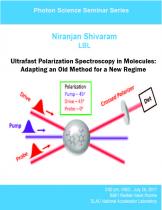Speaker: Niranjan Shivaram, LBL
Program Description
In this talk I will first provide an overview of our experiments to study ultrafast dynamics in molecular systems with ultraviolet and extreme ultraviolet pulses using photo-ion and photo-electron spectroscopy. I will then discuss our ongoing work on studying ultrafast molecular processes using a novel adaptation of the technique of Polarization Spectroscopy also known as Optical Kerr Effect (OKE) Spectroscopy. Polarization spectroscopy is a special case of four-wave mixing (without phase-matching constraints) involving the third order non-linear susceptibility and has been used to study a variety of systems in both frequency and time domains. It is a nearly background free technique which can provide signal sensitivity that is 2 to 3 orders of magnitude higher than transient absorption and can work non-resonantly. In the time domain, this method has been traditionally used to study dephasing dynamics on the ground state and in some cases involving coupling to an excited state. Here, I will discuss our experiments to study ultrafast dynamics on an electronically excited state of liquid Nitrobenzene using three femtosecond pulses. Our goal is to follow excited state dynamics on the femtosecond time-scale using a Polarization probe as a more sensitive and versatile alternative to transient absorption methods. I will present preliminary results using near-infrared pulses and discuss extension of these methods to the extreme-ultraviolet regime.





